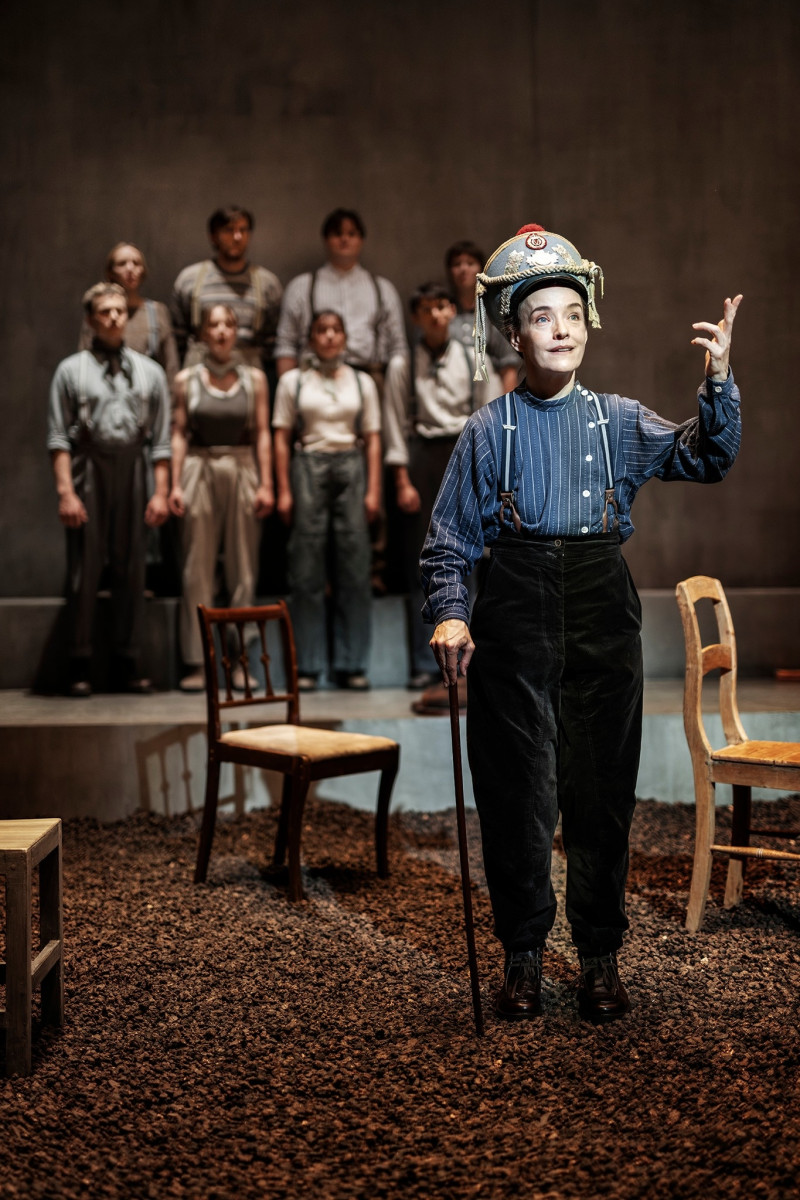En tone, otte åndedræt og klangen af venten

Blot én skuespiller er på scenen i Kejseren af Portugalien – omgivet af otte sangere. I Elisa Kragerups stramt koreograferede iscenesættelse bliver Louise Alenius’ a cappella-komposition en fysisk oplevelse, hvor åndedræt og bevægelse smelter sammen. Den akustiske lydside interagerer besynderligt tyst med de øredøvende, maskinelle lyde, der opstår undervejs, når fx lyskegler på scenen bliver hævet og sænket. Det er, som hvis tilværelsens ubarmhjertighed her i glimt får et lydligt udtryk, der indfanger Selma Lagerlöfs intentioner.
Den sparsomme – eller måske snarere nøjsomme – lydside spejler sammen med de tarvelige bondedragter det hårde, monotone liv i en svensk bygd fra før, verden blev moderne. Og handlingen? En fattig bonde forguder sin datter, men da hun som ung voksen drager afsted til Stockholm uden at vende tilbage, bevirker hans årelange afsavn, at han på donquijotesk manér tror sig kejser over det imaginære land Portugalien, som datteren naturligvis tænkes indsat i som regent. Bondens længsel tangerer vanvid, mens datterens svigt eller tankeløshed ender med at ramme hende selv: På godotsk vis venter og venter han på hende, ligesom hun efter hans druknedød gør det på ham, da hans lig ikke er til at finde.
Stykket præges af en næsten konstant ubrudt drone i koret (frembragt ved hjælp af korisk vejrtrækning), altså en enkelt vedholdende tone, der som kunstnerisk greb illustrerer, hvordan musik i en teaterforestilling kan fremstå så minimal, at klangen i sig selv bliver meddelelsen, og fraværet af et musikalsk narrativ bliver hensigten. »Én tone spillet smukt, det er nok,« sagde Arvo Pärt engang. Bortset fra, at denne tone her bliver sunget, ville han i dette stykke have set sit udsagn bekræftet på radikal vis: Et maksimalt udtryk opnået med minimale midler, som vokalensemblet ÆTLA lykkes med at indfri.
Gåsehud i retten: Når musik bliver til magtspil

En nykomponeret opera i en retssal lyder måske som et banalt greb. Men da jeg træder ind i ventesalen i Aarhus’ Retten til Niels Rønsholdt og Louise Becks Den Stærkes Ret – Den Svages Pligt, er jeg i tvivl, om jeg er gået forkert. Et aflangt rum, borde spredt ud, balkonen ovenover – og så et nodeark i en glasmontre, der formentlig normalt udstiller gamle lovdokumenter. Scenografien er diskret, men den juridiske ramme sætter straks tanker i gang om lov, magt og retfærdighed.
Snart træder næsten 20 sangere frem på balkonen. Musikken er tonal, båret af klangfylde og gentagne fraser, der gradvist forskydes som i en kanon. Man fornemmer lån fra minimalismen, men også en næsten folkelig enkelhed, der gør koret både dragende og foruroligende. Plottet – en datter, der opsøger sin fars spøgelse for at kræve hans våben – bliver kun antydet i brudstykker. Det er stemningen, der driver værket, og det forvandles radikalt, da sangerne forlader balkonen og stiller sig blandt publikum, mens tre dansere bevæger sig gennem salen.
Et nøgleøjeblik opstår, da koret pludselig slår stemmegafler an og placerer dem på bordene, så et vibrerende »wuu-uu« fylder rummet. Gåsehuden er øjeblikkelig. Kort efter synger de direkte til os, med intens øjenkontakt. Det føles både intimt og grænseoverskridende, som at blive tiltalt i en retssag uden mulighed for at svare. Jeg ønskede at kigge væk, men blev fanget i pligten til at holde blikket. Her blev titlen kropslig: den svages pligt at underkaste sig.
Som værket ebber ud, vender alle sangerne sig mod faderen og allierer sig med datteren. Bøger flås ned fra reolerne, sider rives itu, og mens der synges »Lyt og lær«, flimrer Orwells 1984 i baghovedet. Det er både urovækkende og uhyggeligt aktuelt i en tid, hvor autoritetstro og manipulation igen spiller en rolle i det offentlige rum.
Den Stærkes Ret er en af de mest intense musikalske oplevelser, jeg har haft i årevis. Den forener æstetik, krop og samfundskommentar på en måde, der får én til at gyse. Jeg venter allerede på akt to og tre.
Mit navn er Marta Bo – vil du se min playliste?

»Musik rammer mig stærkest, når den vækker længsel. Når jeg mærker den som et stik i maven, kan jeg begynde at tro på en oprigtighed i verden.«
Marta Bo er 24 år, bratschist på fritidsbasis og bachelorstuderende i musikvidenskab på Københavns Universitet. Hun er netop startet som praktikant i Seismograf.
My name is Simon Cummings – would you like to see my playlist?

»Music is inseparable from listening: a close, attentive act. It’s not about beauty, truth or even intelligibility, but connection. This intense, focused intimacy is where meaning and everything else begins.«
Simon Cummings is a composer, writer, and researcher based in England. His music centres on two areas, both of which blur abstract and emotional impulses. The first, explored in instrumental work, involves highly intricate algorithmic processes rooted in carefully-defined behaviours, in a bespoke approach that combines stochastic and intuitive methods to realise large-scale behavioural transformations. His electronic music typically begins with visual stimuli, used to sculpt time-frequency structures investigating the boundary between noise and pitch, reappraising what defines each and their boundaries. He is currently working on a song cycle for voice and electronics for Icelandic soprano Heiða Árnadóttir, to be premièred in 2026. His research is primarily long-form critical writing on contemporary music, published on his website 5:4, as well as in assorted online and print publications.

Skovsøen er et arnested i mere end én forstand. Skovens myriader af liv er afhængige af vandet, men dens piblende forgreninger, intense ro og bløde spejlbillede rummer også stærke musikalske potentialer. Det er præcis sådan en livgivende energi, der danner udgangspunktet for svenske Filip Leymans solodebutalbum, Soft Light. Allerede fra albummets første nummer, »Beyond the Sea«, fornemmer man, hvordan Leyman formår at skabe et organisk univers, hvor enhver lyd gøder jorden for den næste. Det er svært at finde hverken start eller slutpunkt, når de mange synthesizere og strygere vokser ind og ud af hinanden – man må bare overgive sig, og synke ned i det sfæriske univers af rumklange og tung, rolig bas.
Filip Leymans virke kan ikke beskrives uden at nævne svenske Anna von Hausswolff. Hendes musik er som en naturkraft, båret af lange, sakrale orgelpassager – og hvad der er Hausswolff, hvad der er Leyman, er aldrig helt til at afgøre. Soft Light samler årtiers gemte kompositioner og fremstår som en naturlig forlængelse af de mange album og soundtracks, de to har skabt sammen. Albummet rummer en stærk filmisk dimension: i et nummer som »Shapes« kulminerer de lagdelte klange i et blændende klimaks, der føles som slowmotion i lyd.
Leyman optræder her som en musikalsk botaniker, der tålmodigt lader sine synthesizere gro, spire og blomstre. Selvom Soft Light er vokset frem over mange år, lyder det utroligt sammenhængende – som ét langt åndedrag. Albummet synes snarere dyrket end komponeret. Lad os håbe, at Soft Light blot er begyndelsen, og at Leyman lader flere soloalbum vokse frem i samme lys.
Mit navn er Lars Muhl – vil du se min playliste?

»Musik for mig er bevægelse. Når lyden bevæger noget dybt i mig og åbner hjertet, når den vækker kroppen og byder op til dans, når den gør mig eftertænksom. Uanset hvor den kommer fra og hvad end man kalder den, reagerer jeg på om den for mig er ærlig. Hvis den er påstået og ønsker opmærksomhed for opmærksomhedens skyld, hvis den er kunstlet og kun vil sig selv kan jeg ikke tage den ind. Jeg elsker sangere, der synger fra det nøgne og ubeskyttede. Det skal ikke partout være avanceret, men om at blive som barn igen. Pop, rock, jazz, klassisk, det er for mig totalt ligegyldigt, bare det er sandt. Det er det, jeg bestræber mig på, både i mine sange og i mit forfatterskab.«
Lars Muhl er forfatter, mystiker og musiker. Siden 1965 har han – parallelt med sin musikalske karriere – studeret sammenlignende religion og filosofi, og siden 1988 har han specialiseret sig i aramæisk samt kristen og jødisk mystik. I 2003 stiftede han hjælpeorganisationen Hearts & Hands, hvor han fortsat er bestyrelsesformand. Muhl har modtaget DJBFAs Hæderspris (1995) og WBC’s Songwriter Million Certificate (1996) og blev i 2013 optaget på Watkins’ liste over verdens 100 mest spirituelt indflydelsesrige personer.



